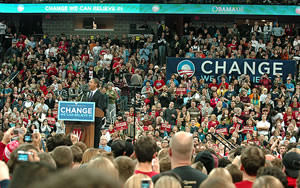Courting the ‘White Vote’
When looking at Sen. Barack Obama's primary election results, I always check the white vote first. I imagine many Democratic National Convention superdelegates do, too. The reason is obvious: Obama is the first African-American with a strong chance of winning the presidency, and his prospects depend on whether whites will give him a vote.
When looking at Sen. Barack Obama’s primary election results, I always check the white vote first. I imagine many Democratic National Convention superdelegates do, too.
The reason is obvious: Obama is the first African-American with a strong chance of winning the presidency, and his prospects depend on whether whites will give him a vote.
On the surface, the news from the Pennsylvania primary was not good for him.
Overall, Sen. Hillary Clinton defeated Obama by 9.2 percentage points. Obama lost Pennsylvania whites to Clinton 62 percent to 38 percent. His numbers dropped among older white voters, with Clinton receiving 67 percent from those over 60. He also lost among whites who don’t have a college degree.
But there is more to this long, increasingly bitter and complicated primary campaign than Pennsylvania. The year’s primary and caucus results, from Iowa through Pennsylvania, show that, from the beginning, Obama has had a strong cadre of white support.
And in Pennsylvania, he actually increased his white vote from what it had been in March in Ohio.
In Ohio, he lost white women by 36 percentage points. He reduced the losing margin to 32 points in Pennsylvania, according to an analysis in Real Clear Politics by Jay Cost [see “A Review of the Pennsylvania Primary”]. Obama lost to Clinton among white men in Pennsylvania by 12 points, an improvement over Ohio, where he lost by 19.
This gain came despite the fact that Obama has been defending himself from the fallout from his former pastor’s speeches and from the inexplicable controversy over his statement that workers worried about joblessness and health insurance are bitter.
Figures compiled by William Saletan in Slate showed Obama winning 53 percent of the white vote in Wisconsin, 42 percent in Maryland, 44 percent in Virginia and a total of 41 percent on Super Tuesday. On that day Obama received more white votes than Clinton in California and tied her in Connecticut. One of his lowest white vote totals came earlier in the primary season in South Carolina, where his 24 percent was considered at the time to be a respectable showing.
Post-Pennsylvania journalistic analysis and punditry made much of the fact that Obama did not win an element of the white vote considered to be blue collar, a classification I have always found hard to define. But if we use education as a blue-collar measure, the exit poll results show Clinton beat Obama among those with no college degree 58 percent to 42 percent. That’s not a bad Obama total.
This compilation of white votes — short a majority but still substantial — show that the white Obama supporters would be part of a strong coalition if Obama faces Sen. John McCain in the fall. What Obama can do that Clinton “hasn’t been able to do is attract independent voters, attract younger voters,” Obama strategist David Axelrod told NPR after the Pennsylvania vote. And, of course, African-American voters.
The next indication will be on May 6, when North Carolina and Indiana hold their primaries. Obama is leading in North Carolina polling, but the Real Clear Politics average of surveys has Clinton slightly ahead in Indiana.
Indiana will be another test of Obama’s ability to win white votes. Its population of 6.3 million is 88.3 percent white. In 2000, only 19.4 percent of those over 25 had a college degree. Most of the residents are not rich. The median household income in 2004 was $43,217. If he wins in this state, it should reduce any doubts about his candidacy.
The immediate question facing Obama is how to campaign in the face of intense attacks by Clinton. Should he reply in kind or concentrate his fire on McCain?
Lee Hamilton, a respected retired Indiana congressman and an Obama supporter, told MSNBC that the senator “can’t entirely ignore” the attacks but “it shouldn’t distract you from the big issues.”
He said his state and the rest of the country “want a politics of consensus building and unity.”
“Health care, war and peace, those are the themes, and you will find Sen. Obama returning to them,” Hamilton said. “The target is the record of the Bush administration and the close ties of Sen. McCain to that record.”
Obama has 1,724 delegate votes, Clinton 1,589, both well short of the 2,025 needed to win the nomination. There are almost 800 superdelegates — elected officials, ex-officials and various other party big shots. Some are committed, but such pledges aren’t binding.
The superdelegates will be carefully studying the election results to see whether Obama or Clinton has the best chance of beating McCain. They will be counting white votes. Unless the pattern changes, it will be clear to them that Obama has received a substantial number but needs more.
But they also know from their children, their other relatives and friends and from their own observation of society that America is changing. Interracial dating and interracial marriage are increasing. Old racial boundaries and prejudices are slowly breaking down. These factors, too, should influence their votes.
Your support matters…Independent journalism is under threat and overshadowed by heavily funded mainstream media.
You can help level the playing field. Become a member.
Your tax-deductible contribution keeps us digging beneath the headlines to give you thought-provoking, investigative reporting and analysis that unearths what's really happening- without compromise.
Give today to support our courageous, independent journalists.






You need to be a supporter to comment.
There are currently no responses to this article.
Be the first to respond.